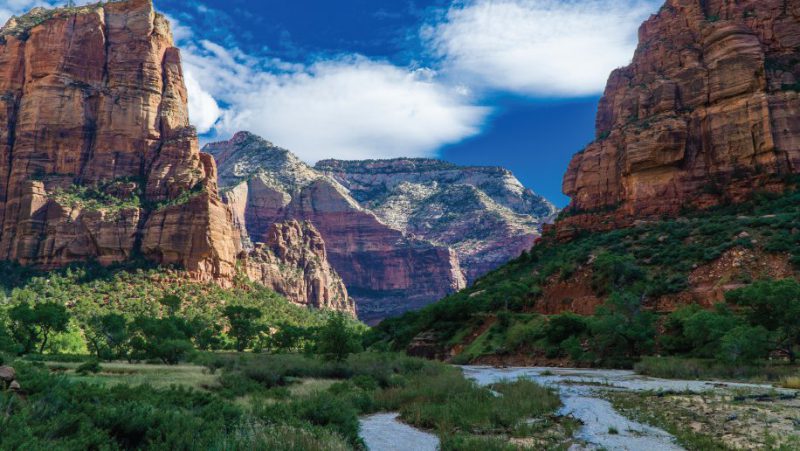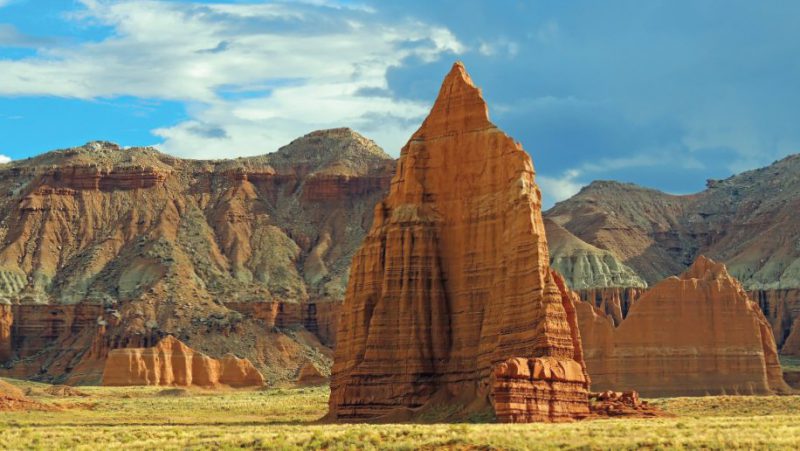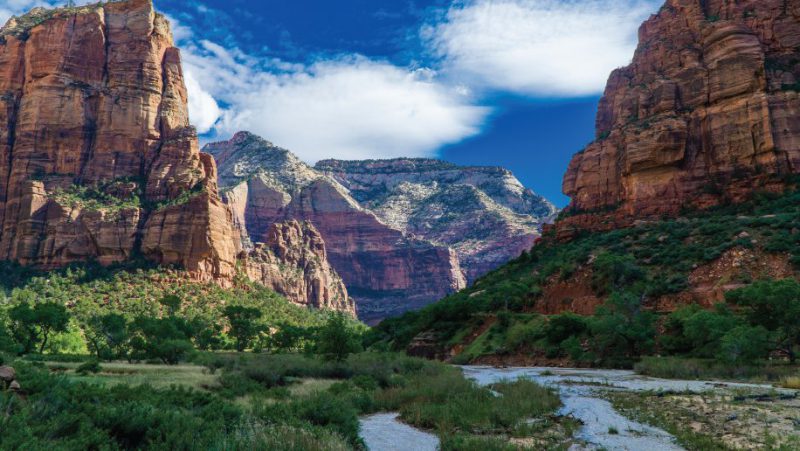Conquering the Big Five
An unforgettable luxury road trip through Utah’s spectacular national parks
September 29, 2020

Landing in Salt Lake City, my eyes were wide open peering over the famous lake that gives the city its name. This is just the start of the natural beauty to come on my journey through Utah’s Big Five national parks. Five parks in five days: that’s the challenge for this quick adventure.
As a result of the COVID-19 pandemic, national parks and domestic road trips have risen in popularity, and I noticed lots of eager visitors ready to enjoy the great outdoors. The parks had plentiful signage encouraging social distancing and mask usage. Most people were wearing masks even when outside, which was appreciated at scenic overlooks and visitor centers. Of course, when you’re alone on a hike, masks are not as much of an issue.
Since my trip was centered around driving, I wanted a rental car that would be both comfortable and stylish for such a long journey and decided to go with Silvercar by Audi. It’s a rental car alternative with all Audi luxury vehicles. Drivers can pick up a car in nearly two dozen cities, but the best part is that the car can be delivered to you. You enter your address in the app, and someone comes to get you (versus the traditional airport car rental desk).
My Audi Q5 was the perfect mode of transportation to take me through the vast and rugged terrain of Utah in comfort. When my new SUV arrived, the Silvercar representative explained how the car’s free wireless Internet and SiriusXM satellite radio worked. Those were appreciated perks for this fast and furious journey.
Armed with my “America the Beautiful Pass” – an $80 annual ticket for unlimited access to hundreds of national parks, monuments, and landmarks – I was off.
My trip would take me from Salt Lake City to Las Vegas via Moab, five national parks, and St. George before returning my Audi Q5 in Las Vegas. Most visitors to these parks spend much longer making this iconic road trip, but my time-crunched experience is meant to be a “sampler” visit for first-timers to inspire some ideas for a longer journey.
Moab and Arches National Park
Moab was my hub to visit both Arches and Canyonlands parks, with my evening filled with exploring the bustling downtown’s shops and restaurants. Just a short drive from Moab is the entrance to Arches National Park, which ended up being my favorite of the five (if I’m allowed such a thing). Its famous namesake arches are postcard-perfect and with just one road winding through the park, it is hard to get lost. The road is easy to follow with ample viewpoints where you can stop for photos, and for those who want to get out and really explore, there are marked paths and trails, too.
Park Avenue is the first major landmark after driving up the winding road from the entrance, and its towering slabs are natural skyscrapers of red sandstone. It’s the most popular trail in the park because it is not difficult, but has some impressive views.
Among the most famous hikes is to Delicate Arch; its precarious rock formation looks stunning against the blue sky, and it is a familiar landmark often used in photos of Utah’s national parks. It’s about three miles roundtrip (a good half hour) from where you would park your car so be sure to pack plenty of water and sunscreen. Other worthy hikes include a visit to Landscape Arch, which is considered to be the longest natural arch in the world at 306 feet, the shorter Windows Hike to see more arches, and Double Arch, which is another short and family-friendly trail. The colors were magical later in the day as the sun began to set behind the towers of rock casting long shadows.
Canyonlands National Park
This park is just under an hour’s drive from Moab. The breathtaking canyon formations are worth exploring, but visitors should do a bit of homework to understand how the park is laid out before planning their trip. Because the park is so large, it is divided into four distinct sections. “Island in the Sky” is the closest to Moab, and it was along my way as I traveled southwest across the state to the next park.
It was an easy and rewardingly scenic hour-long drive through the park to ogle at the landscape from several photo pit stops. Many people I saw were making the famed hike to Mesa Arch, which is supposed to be especially inspiring at sunrise or sunset. On my next visit, I will plan more time to visit the Needles, Maze, and Green and Colorado Rivers sections of the park. There’s so much to explore including prehistoric rock art and the option for guided 4×4 vehicle drives from Moab for the most adventurous. Unfortunately, this park is so large that it’s not possible to take it all in within one (or maybe even two or three days), but my journey to the next stop was calling.
Capitol Reef National Park
In the south-central desert region of Utah, this might be the least known of Utah’s Big Five, but it is growing in popularity. The two-hour drive from Moab is straightforward, and this is a great midday stopping point to explore en route from Canyonlands or Moab. Most travelers will want to overnight here to spend more time hiking Capitol Gorge Trail or the arduous Cassidy Arch Hike where you can actually step out onto one of the arches.
Since I had limited time on my hands, I drove the eight-mile scenic roadway through the park, which takes about two hours if you allow time for quick photo breaks, before going onto the town of Bryce. To me, the reddish-brown sedimentary rock formations look similar to NASA photos of the surface of Mars, and the way the colors seem to change as the sun and clouds pass over them adds to the beauty.
Bryce Canyon National Park
This park (about two hours’ drive from Capitol Reef National Park) is very popular and during the summer months, it can be a challenge to find parking. The park has a shuttle that takes people from a nearby parking lot if you plan to hike while in the park. Like the other parks, I really liked the fact that this visit can be easily enjoyed from your car as you drive through. This is great news for families or those with mobility challenges who won’t miss beautiful views if they don’t hike all of the trails. Still, the adventure of hiking to various parts of the park is a thrill if you’re able, and it’s really the only way to get some of the most prized photographs.
To get down into the canyon, Navajo Loop/Queen’s Garden Trail is a must-do. The trail, best done by walking down, is a 2.5-mile loop through the rocks. When the light is just right, it’s fun to watch the shadows dance between the hoodoos (tall columns of weathered rock). Spending the night in nearby Bryce means you can really enjoy some of the park’s scenery at sunrise or sunset.
Zion National Park
The drive to Zion National Park from Bryce is about two hours, and I chose to make Springdale my base to get out and explore. It is right by the entrance, which like the other parks, is important for those that want to be in the park for sunrise and sunset. I loved my stay at Cliffrose, another Curio Collection by Hilton property, because it’s just a five-minute walk to the park entrance.
The only way to reach the main part of the canyon is to reserve a ticket on the shuttle that takes guests into the park. It costs $1, and reservations are required in advance (due to COVID-19 changes) unless you want to chance it for a walk-up ticket in the afternoon. The system is a bit clunky, requiring you to create an account on a government recreation site; luckily, I was able to score a same-day ticket without a reservation (not recommended if you want to be guaranteed a seat).
If you can’t get a ticket, the Mountain Carmel Highway connects the southern and eastern entrances of the park, which is an alternative way to see the park albeit without the full canyon views that come with the hikes and trails from where the shuttle takes you. Among the most famous is the scenic, but wet (Google it!) hike through The Narrows. Insider tip if you hike it: bring a plastic bag to keep your shoes and clothes separated from the rest of your suitcase; and don’t forget lots of sunscreen and drinking water.
St. George
The drive from Springdale to St. George takes about an hour, and it’s an entertaining grand finale after a week spent in nature. The charming downtown of this urban oasis in the Mojave Desert has plenty of regional culture. The St. George Art Museum has numerous works from area artists, and an outdoor amphitheater at the Tuacahn Center for the Arts hosts regular concerts, plays and events.
This road trip is just a glimpse of the majesty that our great country offers, and once you have the Annual America the Beautiful pass, there are many more national parks calling your name. Utah’s Big Five is a solid starting point with more natural beauty than you can ever imagine.






